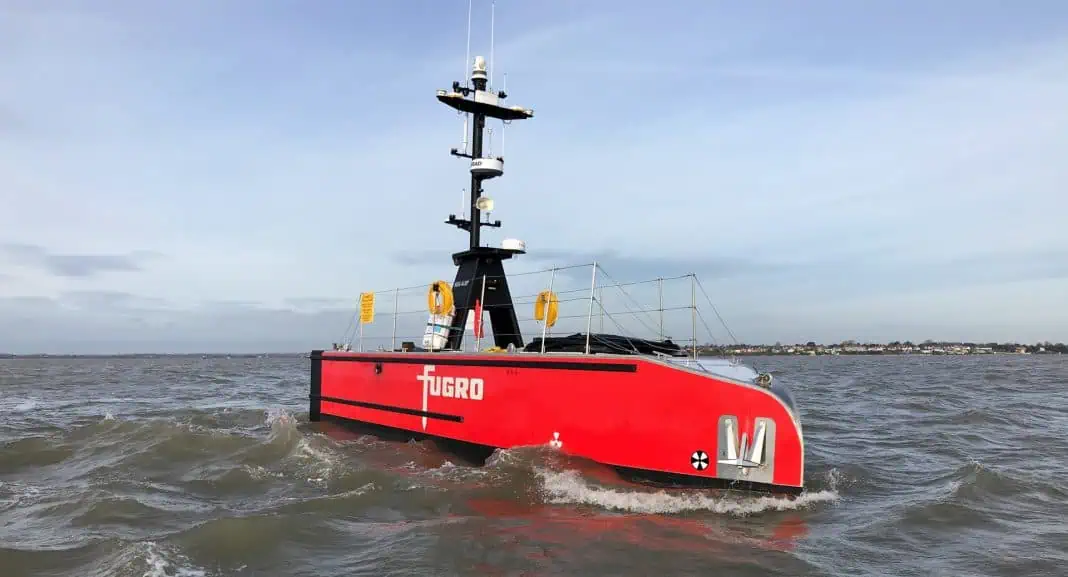An uncrewed surface vessel (USV) that uses ESA Space Solutions satellite technology is helping to collect unprecedented amounts of ocean data. So let’s train our binoculars on SEA-KIT, the remotely-controlled robo-boat that’s making waves in the maritime sector.
The quality of our oceans is declining with an increasing demand for better stewardship of this global resource. As of June 2020 only 20% of the ocean floor had been mapped. However, large vessels are costly and have a heavy operational carbon footprint with frequent crew changes (flights).

“The challenge we’ve always had is the amount of data that needs to be communicated between the vessel and the shore,” says Neil Tinmouth, Chief Operating Officer of SEA-KIT. “This is something that SEA-KIT’s USVs now successfully address.”
SEA-KIT’s 12m Uncrewed Surface Vessel (USV) known as ‘Maxlimer’ proved astonishing capability in conducting long endurance over-the-horizon surveys using satellite communication on a 22-day Atlantic mission in July 2020.Uncrewed vessels operating ‘over the horizon’ are dependent on satellite communication to transfer situational awareness information from the vessel to operators – which can then be assessed to send back appropriate ‘command and control’ signals.
Unexplored ocean frontiers
Maxlimer surveyed more than 1000km2 of previously-unmapped ocean floor on Europe’s continental margin and collected a staggering 1.5 billion data units.
“The vessel receives situational awareness information from six CCTV cameras, a thermal imaging camera, radar and AIS (Automatic Identification System),” says Piera di Vito, Technical Officer at ESA. “This round-the-clock information is sent back to the remote-control centre in Essex via one of the communication channels on board. These communication channels include maritime VSAT antennae with multiple VSAT backup. Throughout Maxlimer’s mission, the communication robustness of the VSAT communication reached just over 98% availability data units.”
SEA-KIT is currently building a series of USVs for leading Geo-data specialist, Fugro, the first of which is now undergoing trials in Australia ahead of commencing uncrewed ROV pipeline inspections on the country’s North West Shelf.
“This is a huge achievement for the British SME, says Piera. “We are thrilled to have helped SEA-KIT in spite of the challenges of the health crisis. This is a hot topic – it can be difficult to find place in the market, but SEA-KIT have done it!
“The strategic partnership with Fugro who supported the project also represents a major acceleration to Fugro’s strategy of leading the development of remote and autonomous solutions – and they have become sustainable commercially”.
Peter Walker, Director of Technology at SEA-KIT, says: “This project has demonstrated the capabilities of current technologies to survey unexplored or inadequately surveyed ocean frontiers. It is a ground-breaking achievement to prove true over-the-horizon capability. Uncrewed vessels are set to play a prominent role in the future of marine survey and inspection.”
Graham Turnock, Chief Executive of the UK Space Agency who co-funded the project through ESA’s Space Solutions Business Application programme adds: “Robot boats could radically change the way we work at sea and this project has given us a unique window into the future potential of satellite-enabled maritime operations.”
ABOUT ESA SPACE SOLUTIONS
ESA Space Solutions is the go-to-place for great business ideas involving space in all areas of society and economy. Our mission is to support entrepreneurs in Europe in the development of business using satellite applications and space technology to improve everyday life. Our programme is designed to provide multiple entry points such as ESA Business Incubation Centres (ESA BICs), ESA Technology Broker Network, and ESA Business Applications programme. Funding typically ranges from 50KEuro to 2MEuro and supports everything from space technology transfer, early-stage incubation programs, Feasibility Studies to large-scale Demonstration Projects.












